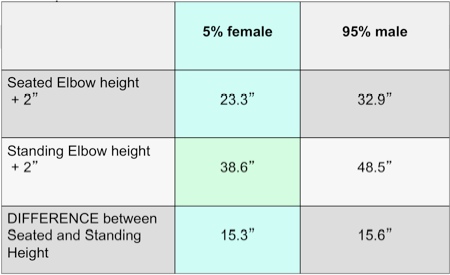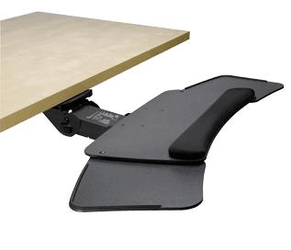All About Keyboard Trays
Posted by Janet Peterson, PT, DPT on 8th Jan 2017
If you work in an office with a fixed-height desk or work surface, chances are that the desk height will be too high for many/most of your workers because the furniture industry guidelines (e.g., BIFMA, or Business and Institutional Furniture Manufacturer’s Association) suggest manufacturers design to accommodate a comfortable seated elbow height and provide leg/thigh-height clearance for the 95%tile male. In many office applications, this results in a desk height of about 29 in. If user adjustable desk height is not an option, one choice that many workplaces make to “fit” their workers is a keyboard tray. This article will discuss when a keyboard tray is most appropriate, what type of keyboard tray to look for depending on the workstation configuration, and considerations for a “sit/stand” keyboard tray.
When to Use a Keyboard Tray
Keyboard trays are a good option for seated work when there’s a mis-match between comfortable elbow height and desk height. Check this by having the worker adjust their chair away from the desk so that their feet are comfortably on the floor, their shoulders are relaxed, their upper arms are resting against their torso, their elbows are bent to around 90 degrees and their wrists and fingers are straight. If the desk is above fingertip level, that’s an indication that a keyboard tray might be helpful. [NOTE: Another option to fix the chair too low/desk too high dilemma is to raise the chair to “meet” the desk height and use a footrest.] If the worker’s job tasks require frequent, intermittent use of desktop equipment such as a 10-key, or extensive handwriting, a keyboard tray might not be the best option because it could result in excessive reaching postures to perform these other job tasks. Also, be sure that there is sufficient clearance behind the worker’s chair to use a keyboard tray, since the tray will position the worker 8 – 12 in. away from the desk edge. Narrow cubicles or limited walking space may interfere with keyboard tray use.
Priority Features to Look for in Any Pullout Keyboard Tray
- Adjustable in height by at least 4 in.
- Adjustable in tilt by at least 15 degrees
- Sturdy enough to not “drift” in height or shake/jiggle with normal keying and mousing pressures
- Low profile (i.e., the tray itself to be thin, no more than ½ in. and ¼ in. is even better)
- Free thigh/knee clearance (i.e., no levers or knobs in the way that your knee or thigh will bump into)
- Able to raise/lower the height without using a knob (i.e., just by holding onto the sides of the tray and lifting or lowering) NOTE: This doesn’t necessarily apply to changing the tilt of the keyboard tray, that often will require turning a knob
- Sufficient width to accommodate both a keyboard and a mouse at the same height (look for at least 26 in. of width); or a tray with a specific mouse platform
Optional Features to Look for in a Keyboard Tray
- Able to fit either a standard or an “ergonomic-style” keyboard. NOTE: You don’t always need an “ergonomic” tray to fit an ergonomic-style keyboard; you just need to be able to remove a "built-in" wrist rest in order to accommodate the ergonomic-style keyboard.
- Able to use the mouse on either the right or the left side. NOTE: Many trays come with an attached mousing surface. Although some of these attached surfaces can be switched from the right to the left side, many of them require tools and time to do so. Single-surface keyboard trays and trays with under-mounted, sliding mouse surfaces do not require any tools to switch from right-handed to left-handed mousing. I tend to recommend single-surface or under-mounted mousing surfaces to my clients to maximize the ease of user adjustability.
- Extra width to accommodate additional equipment. This can be helpful if the worker uses a small notepad for taking handwritten notes or uses a small 10-key that can be placed at the level of the keyboard and mouse. The downside of an extra-wide tray is that it may decrease the stability of the tray.
Additional Considerations for Corner or "U" Shaped Workstations
Keyboard trays can be purchased either as two separate pieces (the “arm” that attaches to the underside of the desktop and the “tray” that is the platform to hold the keyboard and mouse) or as one combined unit. Since there is less horizontal space in a corner or “U” shaped workstation, you will most likely need the longest “arm” available so that the worker can pull the keyboard tray out far enough to clear the sides of the desktop. You will also most likely need a keyboard tray that either has a sliding, under-mounted mousing surface or else an attached mousing surface. If you choose a model of tray with a sliding mouse surface, the mouse platform will sit slightly below the rest of the tray. In that case, you may need to build up the mouse platform with multiple (stacked) mouse pads, a small book, or pad of paper to bring the mouse surface height up to the level of the keyboard. Another option that is available for corner desk configurations is a corner “wedge” that can be installed to decrease the depth of the corner and allow the monitor to be positioned closer to the keyboard.
Sit/Stand Keyboard Trays
Many vendors are now promoting “sit/stand” keyboard trays that are advertised to be able to allow the worker to easily change from a seated position to a standing position. Most of these keyboard trays do not adequately adjust to both a seated and a standing position and I caution you to carefully research and consider what the worker’s needs are for a sit/stand configuration. Using anthropometric tables (see table, below) for seated and standing elbow height for the 5%tile female and the 95%tile male, the typical difference between seated and standing height is at least 15 in. That means that a sit/stand keyboard tray will need to adjust approximately 15 in. in height to work effectively as a sit/stand device, no matter how tall the individual is.

Many keyboard trays that are advertised as “sit/stand” only offer 9 in. or 10 in. of height change. This will not be sufficient for the vast majority of workers. Other models of sit/stand keyboard trays do allow for 14 in. or more of height excursion, but the movement is split from below and above the desk height. For example, if you have a fixed height, 29 in. desk and 14 inches of split total excursion, the 7 in. above the desk height would be 36 in., not high enough even for the 5% female to use in a standing position. All that said, some sit/stand keyboard trays can be made to work by adding a riser piece under the tray piece of the tray mechanism or by adding a scissor platform to the tray itself to provide additional height in a standing position.
In addition to the necessary height excursion for the keyboard tray to create a sit/stand arrangement, keep in mind that the monitor height will also need to be easily raised and lowered.
The Bottome Line
Adjustable keyboard trays can be a great way to provide an ergonomic fit for workers when the fixed-height work surface is too high. When purchasing new office furniture, buy adjustable-height work surfaces to eliminate the need for keyboard trays.
References
Ergonomic Design for People at Work, Second Edition; Eastman Kodak Company, John Wiley & Sons, New Jersey, 2004.
ANSI/HFES 100-2007 Human Factors Engineering of Computer Workstations, Human Factors & Ergonomic Society, 2007.
Janet Peterson, PT, DPT, has been performing injury prevention services for over twenty years; she has had her own business in ergonomic consulting, JP Ergonomics, since 1998 in Seattle, Washington. Dr. Peterson earned her master’s degree in physical therapy from Stanford University and her doctorate in physical therapy from Temple University. She is a past president of the Puget Sound Human Factors and Ergonomics Society (PSHFES) and a member of the Pacific Northwest Ergonomic Roundtable.
This article originally appeared in The Ergonomics Report™ on 2012-06-20.

